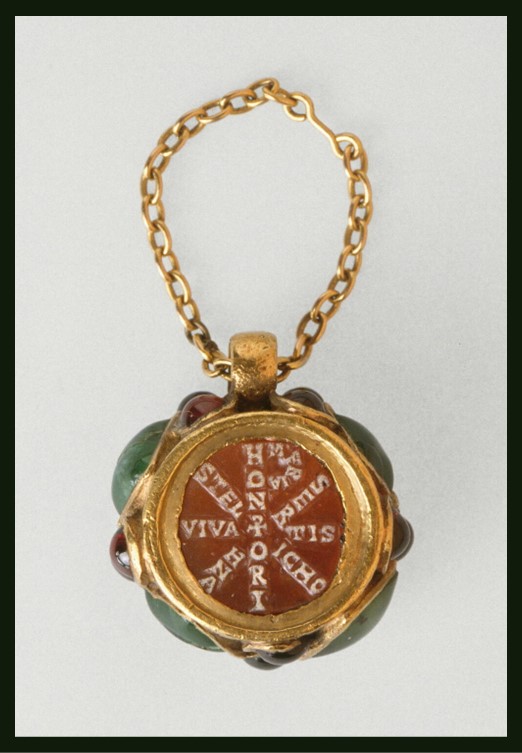
Late Antique poetry has often been characterized by its ‘jeweled style,’ in which authors mobilized ornament, variety, and tessellation for the purposes of visual splendor and immediacy. Jewels, and treasure more broadly, also serve as particularly effective metonyms for power. And historians frequently describe the programmatic effort to bolster dynastic power over the course of the fourth century as a ‘dynastic imperative.’ Is The Enkolpion of Empress Maria in the collection of the Louvre an example of Imperious Power? Worn around the neck of Empress Maria, was this unique Enkolpion an integral part of the sustained program of dynasty building in the tumultuous years following the death of Emperor Theodosius I? https://www.doaks.org/events/byzantine-studies/2022-2023/dynastic-jewels-a-late-antique-rhetoric-of-treasure-and-adornment
Empress Maria’s Enkolpion is a small piece of jewelry, 1.3 x 1.8 cm in size, and round in shape. It is a flat receptacle of earth grains probably from the Holy Land, smelling, at the time of its discovery, of musk. The two white and russet orange agate cameos it is made of are attached back to back by a band of gold adorned with emeralds and rubies. How splendid can it be! It can… if you consider the cameos’ simple, yet ‘powerful’ decoration.
Both cameos are embellished with inscriptions, in the shape of Christograms, cut in very low relief, arranged spikelike around a central ansate cross. One cameo reads: Honorius and Maria (the loop of the letter Rho), Stelicho, Serena, vivatis in Deo, and the other cameo reads: Stelicho and Serena (the loop of the letter Rho), Eucherius, Thermantia, vivatis in Deo. Everyone mentioned by name in the two inscriptions is an important member of the Theodosian Dynasty! https://www.metmuseum.org/art/metpublications/Age_of_Spirituality_Late_Antique_and_Early_Christian_Art_Third_to_Seventh_Century
Maria’s Enkolpion, suggested to be a wedding gift, is a family heirloom! Stelicho, for example, of Vandal origin, was a powerful military commander in the Roman army. Married to Serena, the niece of emperor Theodosius I, and guardian for the underage Emperor Honorius, Stelicho was the father of Maria, Emperor Honorius’s first wife, Thermantia, the young Emperor’s second wife, and Eucherius. If this isn’t a ‘dynastic imperative’ then what can it be?
The Enkolpion was found in February 1544, in Rome, in a sarcophagus in what was once the Mausoleum of Emperor Honorius, later, during the 8th century, converted into the Chapel of Saint Petronilla. The Mausoleum was built next to the Vatican Rotunda, another round structure on Vatican Hill, beside Old Saint Peter’s Basilica in Rome.
The Mausoleum was used as the resting place for members of the Theodosian Imperial family. The first to be buried was Augusta Maria, the first wife of Honorius, who died young, before 408. Honorius, the first emperor of the Theodosian dynasty was also entombed there in 424. The Mausoleum was used as a resting place for Honorius’s second wife Thermantia, and probably, Honorius’s sister, Augusta Galla Placidia, her husband Augustus Constantius III, and her sons Theodosius and Valentinian III. https://en.wikipedia.org/wiki/Mausoleum_of_Honorius
For a Student Activity, inspired by The Enkolpion of Empress Maria, please… Check HERE!